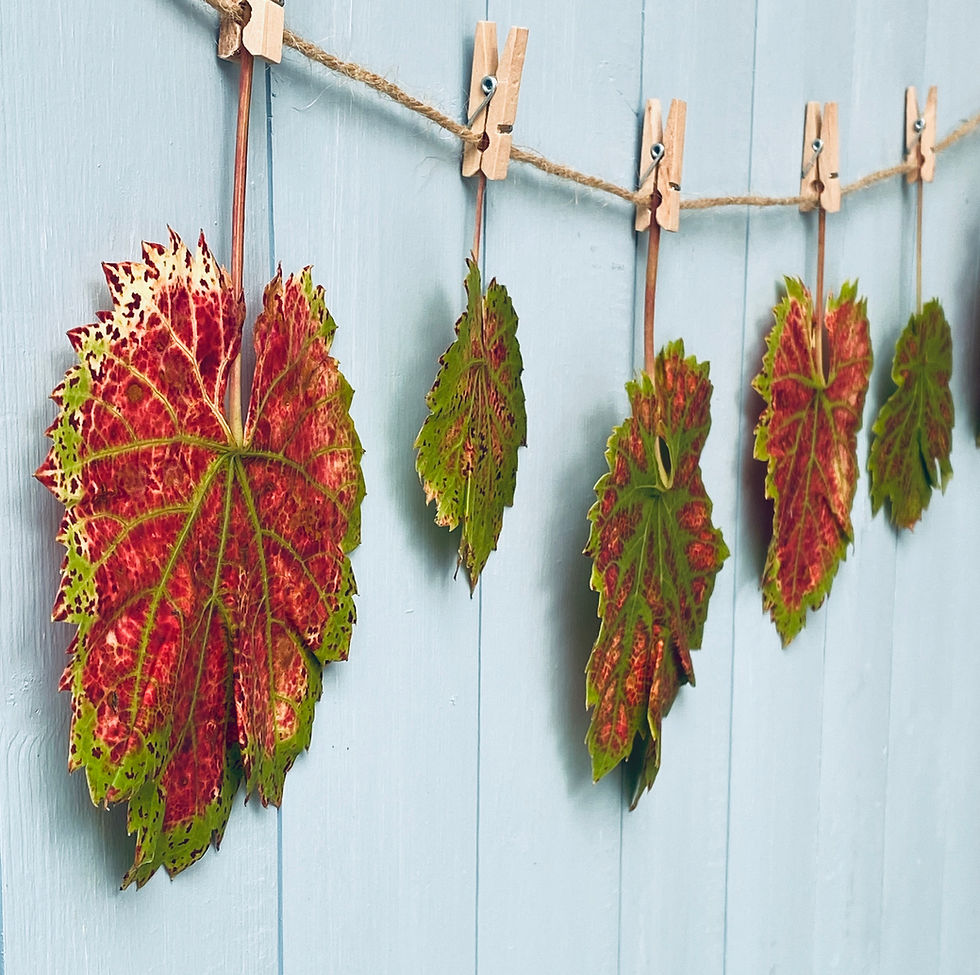Botanical Bunting
- Cathy Crozier-Cole

- Sep 23, 2021
- 3 min read
Updated: Sep 24, 2021
Make your own display of autumn treasures
I can’t believe it – it’s September already. Suddenly the nights are drawing in and there’s a subtle, earthy change in the air. In the cutting patch the dahlias and rudbeckias are blushing in the deep reds of late summer, and in the hedgerows the berries are ripening; hidden jewels amid a tangle of old man’s beard.

For me September is always a time of reflection; the returning of a gentle rhythm to life after the excesses of summer. The slower pace of autumn suddenly seem alluring, necessary, like a tonic. I feel myself breathing out, taking a slightly longer route on my walk, and noticing the subtle changes around me in nature, which reflect my shifting mood.
I often find myself gathering found objects of nature for a nature table. The nature table seems to be something of a lost treasure. My memories of school are rich with the thrill of finding something worthy of display, like a fragment of robin’s egg or patterned feather, on the walk to school. When my children were young I restarted this tradition, and our dinner table was awash with seasonal scenes; I borrowed from their furry toy collection of mice and rabbits to mix with my botanical finds. Looking back, I think these displays satisfied more of a playful urge on my part than in the children!
Years later I still like to gather, just for myself.
One simple way to present found treasures is as home made botanical bunting. It’s such a simple thing to make, and looks so effective hung against a wall or window, or suspended from a mantlepiece. After the blousy botanical exhibitionism of summer flowers, sometimes the simplicity of a single rosehip, or faded seed head, is all that’s required. Muted understatement; a quiet gift.
If you’d like to have a go at making your own botanical bunting, here’s how.

All you need is some jute string (or any cord or ribbon will do), and some small wooden craft pegs (between 3-4cm long is perfect). If you don’t have these, paperclips are a good alternative, as they’re nice and lightweight.
Suspend your string or cord by tying the ends to something suitable (a pair of wall light fittings work well, as long as the string is not in contact with the bulb), or by using drawing pins, or concealed blu tac or tape. These should work fine if what you're hanging from them is not too heavy.
Take a trip into the garden or a walk in the hedgerows and see what botanical treasures catch your eye. In the examples pictured I’ve used:
Fennel, scabious and millet from the cutting patch
Rosehip, verbena bonariensis, achillea, zinnia, sanguisorba and nigella seedpod
Coloured vine leaves from our grape vine (lightly pressed between kitchen roll for a few days so they lie flat)

But you can use anything you like: flowers or seedpods from the autumn border, berries and old man’s beard from the hedgerow, autumn leaves gathered as their colour starts to turn, grasses in small sprigs from the meadow.
Dried umbellifers like hogweed or allium seedheads can work well for a more 3D display. Fern leaves or copper beech can be pressed flat for a few days, or left to curl naturally. Honesty (lunaria) could look magical in a window, where its silvery ovals will catch the light.
Sprigs of herbs, like lemon balm, mint, rosemary, sage, thyme or bay leaves, can be hung to dry, in a form of culinary bunting, from where they can be used later on to cook with or brew herbal teas. In a larger version, whole bunches of flowers or herbs could be hung in a line to dry, useful for creating winter arrangements.
Above all, have fun and be playful. Immersing ourselves in a creative activity based on nature has proven benefits for our wellbeing. It’s a chance to slow down and reconnect with our inner sense of play, and sensory connection with the natural world.
I'd love to see what you create; do share with me on Instagram or Facebook @umbelflowers.
Whatever your activities this month, I hope you find some mindful moments to enjoy the gradual shifting of the season. And I wish you a happy autumn.





Comments